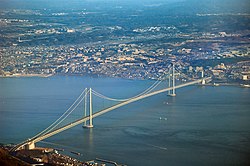Akashi Kaikyo Bridge 明石海峡大橋 | |
|---|---|
 Akashi Kaikyo Bridge from the air, December 2005 | |
| Coordinates | 34°36′58″N 135°01′14″E / 34.6162°N 135.0205°E |
| Carries | Six lanes of the |
| Crosses | Akashi Strait[1] |
| Locale | Awaji Island and Kobe[1] |
| Other name(s) | Pearl Bridge[2] |
| Maintained by | Honshu-Shikoku Bridge Expressway Company Limited (JB Honshi Kōsoku) |
| Characteristics | |
| Design | Suspension bridge[1] |
| Total length | 3,911 metres (12,831 ft) |
| Height | 282.8 metres (928 ft) (pylons)[1] |
| Longest span | 1,991 metres (6,532 ft)[1] |
| Clearance below | 65.72 metres (215.6 ft) |
| History | |
| Designer | Satoshi Kashima |
| Construction start | 1988[1] |
| Construction end | 1998[1] |
| Opened | April 5, 1998 |
| Statistics | |
| Toll | ¥2,300 |
| Location | |
 | |
The Akashi Kaikyo Bridge (Japanese: 明石海峡大橋, Hepburn: Akashi Kaikyō Ōhashi) is a suspension bridge which links the city of Kobe on the Japanese island of Honshu and Iwaya, Awaji on Awaji Island. It is part of the Kobe-Awaji-Naruto Expressway, and crosses the busy and turbulent Akashi Strait (Akashi Kaikyō in Japanese). It was completed in 1998,[1] and at the time, was the longest central span of any suspension bridge in the world,[3] at 1,991 metres (6,532 ft). Currently, it is the second-longest, behind the 1915 Çanakkale Bridge in Turkey that was opened in March 2022.
The Akashi Kaikyo Bridge is one of the key links of the Honshū–Shikoku Bridge Project, which created three routes across the Seto Inland Sea.
- ^ a b c d e f g h Cite error: The named reference
structuraewas invoked but never defined (see the help page). - ^ "Akashi Kaikyo Bridge, Akashi Strait, Japan". Road Traffic Technology. Archived from the original on October 2, 2016. Retrieved September 23, 2016.
- ^ Cite error: The named reference
hsbewas invoked but never defined (see the help page).